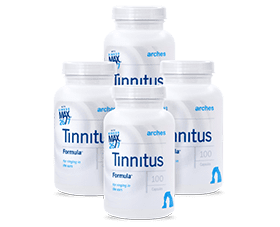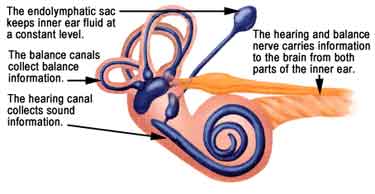By Barry Keate
Barry Keate, has lived with tinnitus over 40 years and has published 150+ research articles on numerous aspects of tinnitus. He is an expert on the condition and a well-known advocate for those with tinnitus.
Meniere’s disease, vertigo and tinnitus are three conditions that are very closely related. While not all tinnitus sufferers experience vertigo, nearly everyone with Meniere’s disease experiences severe vertigo, tinnitus, hearing loss and a feeling of fullness in the ears. This can be very frightening and a typical episode can last from two to four hours to more than a day or longer. Meniere’s disease is progressive and results in permanent hearing damage. Eventually 50-95% of hearing in the affected ear will be lost.
 Meniere’s disease gets its name from the French physician Prosper Meniere, who first described the illness in 1861. In 1981 a group of Otolaryngologists founded The Prosper Meniere Society. This group’s primary goal is to promote the academic dissemination and discussion of clinical research data on Meniere’s disease and all aspects of inner ear dysfunction, pathophysiology, diagnosis and treatment.
Meniere’s disease gets its name from the French physician Prosper Meniere, who first described the illness in 1861. In 1981 a group of Otolaryngologists founded The Prosper Meniere Society. This group’s primary goal is to promote the academic dissemination and discussion of clinical research data on Meniere’s disease and all aspects of inner ear dysfunction, pathophysiology, diagnosis and treatment.
 Vincent van Gogh, whose artistic brilliance and supposed madness have made him a focus of popular fascination, suffered not from epilepsy or insanity but from Meniere’s disease, a new analysis of his letters suggests. An article in the Journal of the American Medical Association suggests that the 19th Century Dutch painter suffered from Meniere’s disease, a condition that was little known at the time and has often been misdiagnosed as epilepsy.
Vincent van Gogh, whose artistic brilliance and supposed madness have made him a focus of popular fascination, suffered not from epilepsy or insanity but from Meniere’s disease, a new analysis of his letters suggests. An article in the Journal of the American Medical Association suggests that the 19th Century Dutch painter suffered from Meniere’s disease, a condition that was little known at the time and has often been misdiagnosed as epilepsy.
Today, Meniere’s disease affects about 2 out of every 1,000 people. There are approximately a half million sufferers in the US. About 75% of those affected have it in one ear while 25% have it in both. It generally strikes people in their 40s and 50s although some cases have been found in people in their 20s. No cases in children have ever been reported.
A Matter of Balance
Balance disorders fall under several broad categories including peripheral vestibular disorder, central vestibular disorder, systemic disorder and vascular disorder. Peripheral disorders are disturbances in the labyrinth, or inner ear. Central disorders are problems in the brain or connecting nerves. This can include a rare tumor called acoustic neuroma. Systemic disorders are problems of the body other than the brain or head. Vascular disorders are related to blood flow problems.
Peripheral vascular disorders are the most common. They fall into five categories:
1 Meniere’s disease – an inner ear fluid disorder that causes vertigo, hearing loss, tinnitus and fullness in the ear. 2 Benign Paroxysmal Positional Vertigo (BPPV) – a brief, intense sensation of vertigo that occurs because of a specific positional change of the head. 3 Labyrinthitis – an infection or inflammation of the inner ear causing dizziness and loss of balance. 4 Vestibular neuronitis – a viral infection of the vestibular nerve. 5 Perilymph fistula – a leakage of inner ear fluid to the middle ear.
The balance system works with the visual and skeletal systems to maintain orientation. Visual signals are sent to the brain and compared to information from the vestibular systems and muscles and joints.
An organ in the inner ear, the labyrinth, is a central player in the vestibular or balance system. Inside the labyrinth are three semicircular canals which are filled with fluid. As the head moves, the fluid inside the semicircular canals signals to the brain its relative motion. Each semicircular canal has a bulged end that contains hair cells. Rotation of the head causes the fluid to flow, which in turn causes displacement of the top portion of the hair cells. The endolymphatic sac is a fluid reservoir that keeps the fluids in a constant volume in the semicircular canals.
Two other organs which are also part of the vestibular system, the utricle and saccule, are responsible for detecting linear acceleration, or movement in a straight line. The hair cells in theses organs are blanketed with a jelly-like layer which contains tiny calcium stones called otoconia. When the head is tilted or the body position is changed with respect to gravity, the displacement of the stones causes the hair cell to bend, providing proper balance
Treatment
The underlying cause of Meniere’s disease is unknown. What is known is that there is a fluid imbalance, generally a pressure build-up, within the semicircular canals that causes the hair cells to react as though the head is spinning when, in fact, it is not. There is also generally a feeling of fullness in the ears. This can also be caused by a viral or bacterial infections or leakage from the labyrinth into the middle ear. These conditions can be treated medically and anyone experiencing vertigo should see their doctor.
Medication
In the event that the cause is Meniere’s and not an infection, there are several medical treatment possibilities which have varying degrees of success. Treatment may consist of medication to improve inner ear circulation such as blood pressure pills, which are vasodilators. Diuretics with anti-dizziness medication are also used to reduce pressure buildup. Special diets low in sodium and potassium are frequently recommended. Salt plays a damaging role in reducing circulation in the inner ear and can aggravate both Meniere’s and tinnitus. Patients are also advised to discontinue use of caffeine, nicotine and alcohol.
Sometimes medication is applied directly to the inner ear by methods called transtympanic injection or perfusion. Dr. Michael Seidman is in the forefront of this medical therapy and has written an article titled “Medicines to Treat Inner Ear Disorders“.
Transtympanic perfusion is a procedure where a small hole is made in the eardrum. A micro-catheter is fitted through the hole and surgically attached to the round window. Medication is placed in the micro-catheter which then slowly perfuses through the round window and into the cochlea. This is accomplished on an out-patient basis and the micro-catheter is typically left in place for several weeks with a constant supply of medication being applied.
One antibiotic sometimes used is gentamicin which is related to streptomycin. It was first put into widespread use in the mid-1940s to treat tuberculosis. One unfortunate side-effect was that it damaged the hearing and vestibular system and frequently resulted in deafness. Otolaryngologists quickly realized that this negative effect could be put to good use in people with Meniere’s disease. By intentionally killing off part of the vestibular system that caused extreme vertigo, they could stop the dizziness. This therapy is quite successful however the risk of total hearing loss has averaged around 30-40%.
Corticosteroids are also used in the management of several inner ear disorders including Meniere’s disease. Dexamethasone is a well known steroid that possesses potent anti-inflammatory properties. In one study, Meniere’s patients were treated with a combination of Lidocaine and Dexamethasone by inner ear transtympanic perfusion. Eighty three percent (83%) of the patients treated with transtympanic perfusion experienced immediate relief from ear fullness and dizziness; 69% of patients had sustained relief after one year.
Surgery
There are also surgical treatments available for Meniere’s. These treatments are only recommended when other treatments fail to relieve attacks of dizziness and pressure. Surgery is successful in relieving acute attacks in the majority of patients.
An Endolymphatic Shunt drains excess fluid from the inner ear. This operation is only advised when hearing is relatively intact. An incision is made behind the ear, through the mastoid bone and a tube is inserted to control the abnormal fluid pressure. In severe cases where the shunt is unsuccessful, it is sometimes necessary to remove the inner ear membranes. This will stop episodes of vertigo however there is a total loss of hearing in the affected ear.
Ginkgo Biloba Extract
Two of the ingredients found in Arches Tinnitus Formula®, Ginkgo biloba extract and zinc have been clearly shown to be helpful for Meniere’s disease and vertigo. Several studies conducted using premium-grade Ginkgo biloba extract have demonstrated it’s superiority over placebo and equivalency to a popular anti-dizziness medication. One study, conducted in France on 70 patients with vertiginous syndrome, reported that over a 3 month period “47% of patients who received Ginkgo biloba extract (EGb 761) were rid of their symptoms as against 18% of those who received the placebo.” (1)
In an Italian study, 44 patients complaining of vertigo caused by vascular vestibular disorders were randomly treated with EGb 761 or with betahistine dihydrochloride for 3 months. Both drugs reduced the speed of vertigo but betahistine dihydrochloride considerably reduced, where EGb 761 considerably improved, the visual-vestibular association. (2)
Betahistine dihydrochloride is popularly known as SERC. It is not currently available in the US. The FDA has not approved its use due to numerous side effects.
A Polish study combined EGb 761 and kinezytherapy, a type of physical rehabilitation used for neurologically impaired patients, such as those with MS. They compared a group using EGb 761 and kinezytherapy with those using kinezytherapy alone. Their conclusions state that “Control examination revealed gradual improvement in vestibular tests in both groups (with and without ginkgo extract) but in patients treated with EGb 761 the improvement was clearer and faster in dynamic posturography. It implies a central effect of ginkgo biloba extract that allows fuller vestibular compensation sooner.”(3)
An excellent French compilation of the benefits of ginkgo provided an overview of clinical studies titled “Ginkgo biloba extract (EGb 761): State of knowledge in the dawn of the year 2000”. This overview discusses all the health benefits of ginkgo and the conditions that are treated by it. One section reads “Regarding the vestibular and auditory systems, experimental and clinical studies have shown the efficacy of EGb 761 in treating hypoacusis, tinnitus, vertigo, dizziness and other symptoms of vestibulocochlear disorders.” (4)
References
- Haguenauer JP, Cantenot F, Koskas H, Pierart H. Treatment of equilibrium disorders with Ginkgo biloba extract. A multicenter double-blind drug vs. placebo study. Presse Med 1986 Sep 25;15(31):1569-72.
- Cesarani A, Meloni F, et al. Ginkgo biloba (EGb 761) in the treatment of equilibrium disorders. Adv Ther 1998 Sep-Oct;15(5):291-304.
- Orendorz-Fraczkowska K, Pospiech l, Gawron W. Results of combined treatment for vestibular receptor impairment with physical therapy and Gingko biloba extract (EGb 761). Otolaryngol Pol 2002;56(1):83-8.
- Clostre F. Ginkgo biloba extract (EGb 761). State of knowledge in the dawn of the year 2000. Ann Pharm Fr 1999 Jul;57 Suppl 1:1S8-88
Get Free Shipping!
Order now and get free shipping on either the Tinnitus Starter Kit or Combo Pack. Try the doctor recommended products with clinically proven ingredients for tinnitus. No coupon code required.


